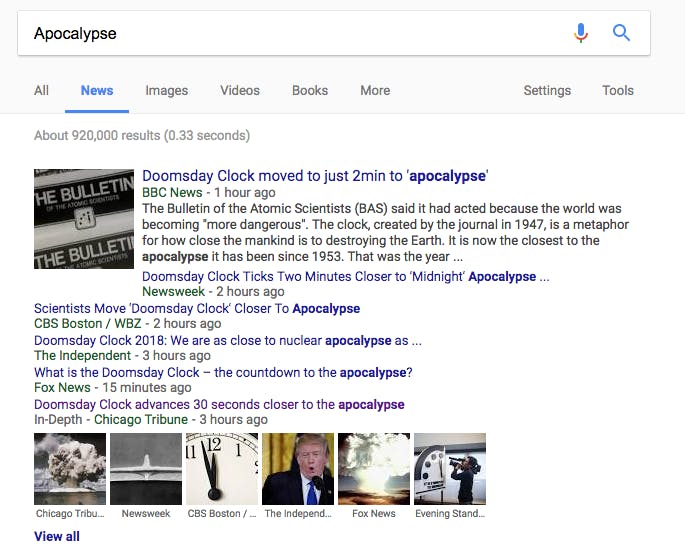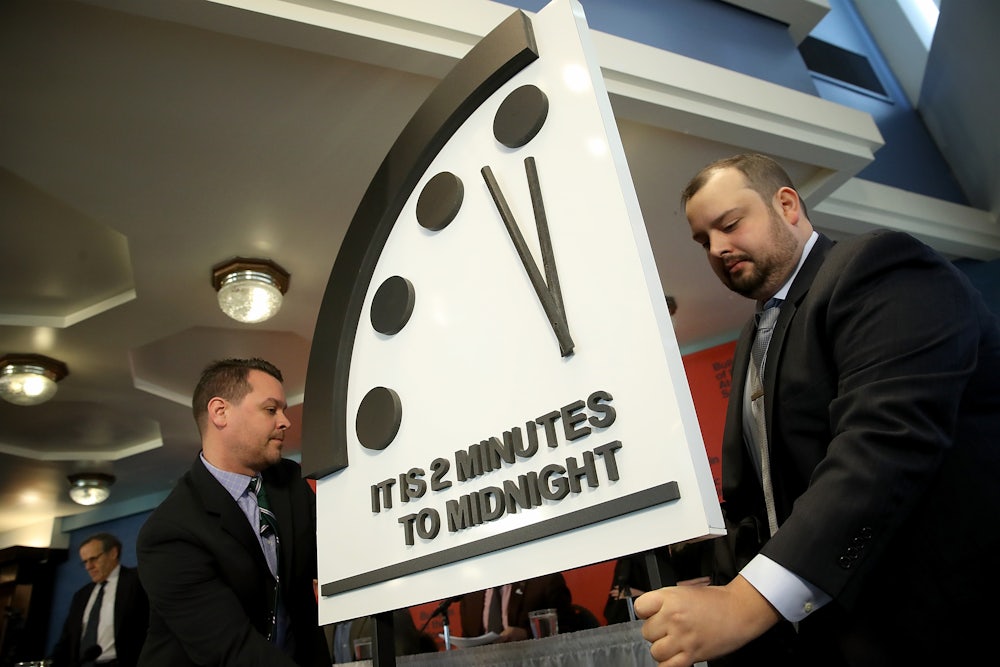The apocalypse looms, ya’ll. On Thursday, the Bulletin of the Atomic Scientists announced that the infamous, symbolic “Doomsday Clock” had moved 30 seconds closer to midnight. It’s now two minutes to midnight, closer than it has been since 1953, when the hydrogen bomb was first tested. Midnight represents—well, you know. Boom.
The Bulletin has been updating its Doomsday Clock periodically since 1947, its hour-hand stuck reliably on eleven and its minute-hand moving closer to or farther away from midnight, depending on how screwed up the world is. At first, the clock’s time was solely based on the threat of nuclear war, but today, scientists consider nuclear apocalypse along with other existential threats like climate change and cyberattacks. Along with reliably freaking people out, the Doomsday Clock has also turned the imminent catastrophic destruction of our only planet into a fun annual news event. Just look at all the headlines!

I am skeptical of the value of this clock, which appears to me an unscientific exercise in freaking people out. So I called up Lawrence Krauss, the famous theoretical physicist and cosmologist and chair of the Bulletin’s Board of Sponsors, to convince me otherwise.
Imagine having a clock on your wall that sometimes ticks forward and sometimes ticks backward. You never know which way it’s going to tick, and it never gets to twelve o’clock. Doesn’t that clock kinda suck?
[Laughs]. Well, actually, if it doesn’t get to twelve, it doesn’t suck at all. It’s when it gets to twelve that it gets really bad. But look, it was a graphical image that was invented in 1947. And it had resonance. So, it’s a symbol. You’re right in a sense, and one could have picked very different symbols.
But there’s little doubt that [the clock] has had a global impact. It has entered the lexicon, and the lexicon of Hollywood among other things. And you can ask, what’s the point of having the clock, which you will say isn’t scientific and doesn’t behave like a real clock. But the purpose of it is to alert the public to dangers that the public doesn’t normally consider. If the public isn’t aware and isn’t concerned about those dangers, then governments will do nothing.
The clock is an effective symbol, and maybe it’s silly to get hung up on the metaphor. But you’re a scientist—an advocate for rational thought. And sometimes it feels like this symbol creates irrational drama: It has people thinking we’re inevitably going to tick to midnight. As a scientist, how do you feel about using an analogy that’s obviously false?
As a scientist talking to the public, every day I use analogies that are false. In order to describe dark energy or the fundamental structure of atomic nuclei, which can really only be discussed mathematically, I have to invent analogies that are never exact.
So yeah, I have issues with hitting on emotions. But this is a political question, it’s not just a scientific one. Scientists have a responsibility—which is the reason I’m involved in this—to try and alert the public to the realities of the world, and if you have use emotional tools to do it, you should.
I wrote a book called The Physics of Star Trek, right? That’s because, if you tell people you’re a physicist at a party, they’ll say, “Oh, how about those Patriots?” But if you start talking about warp drive or time travel, then people begin to realize that they actually are interested in science. Whenever I write something popular, I don’t actually expect it to really be teaching that much. What I expect to do is motivate people to want to learn. And in my mind, that’s what the clock does.
Effectiveness is important, but so is accuracy. This clock is made by scientists. So what’s the methodology? When the clock was only about nuclear doom, how did you calculate it? And now that you’ve integrated climate change and other factors in, how do you calculate across so many different variables?
You are ascribing to it significance that it doesn’t have. It’s not scientific. Two minutes is not a scientific calculation, like the mass of the proton. It’s a number that’s arrived at by a group of people who are exploring each of the questions, then having a huge amount of discussion, and ultimately a convergence on a number. And that number is frankly arbitrary. It’s not a scientific quantity.
That’s why I often say that, from an empirical perspective, what’s important is not the clock’s absolute value but the derivative. Are we moving it forward or backward? Is the world getting more dangerous or less dangerous? We can we can argue about that much more effectively.
So if it’s two minutes to midnight versus two minutes and ten seconds to midnight, people shouldn’t take that as something significant. What is significant is that, when we moved the clock to two minutes, it now has the value that’s equal to the closest its ever been to midnight in the last 71 years.
If the world does get more dangerous, are you more likely to get into smaller and smaller numbers, like ten seconds? five seconds?
This comes up every year because people say the real estate is shrinking. It is. If next year gets more dangerous, you’re likely to see it change in smaller increments. Psychologically, people want there to be real estate left between now and doomsday.
So, I cannot tell you what’s going to happen. But certainly this year we made a statement by moving it as close to midnight as it has even been. If next year we move it closer, you can be darn sure that’s going to be a dramatic statement.
I feel like I already see the threat of nuclear war every day. I also see the increased likelihood of super-hacks and climate change. I don’t need the added drama of the clock, because when I look at the news every day, I already see the apocalypse. What does the clock provide for people like me?
Well, first of all, if you already know about it, you shouldn’t feel worse just by having someone else talk about it. It should validate your own perceptions. We’ve tried very carefully not to just give people the numbers. We try and say what would be required to move the clock back. What are the real policies that would be required to make to make the world safer from these threats?
What the clock can provide is hope, because every year we point out that these problems are all solvable. These are not like insolvable physics problems. They’re all political problems that are solvable in principle if we have the political will.
What we need to do is is be realistic about about the dangers and the opportunities. And then, in a democracy, people can choose to act or not to act. So when people see this clock, they can either get so scared and depressed that they decide not to do anything, or they can get angry and decide to do something—whether it’s voting for the first time, marching, or writing letters.
This interview has been lightly edited for clarity and length.
